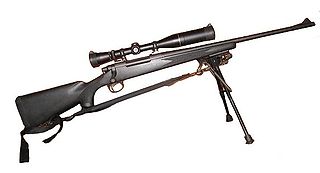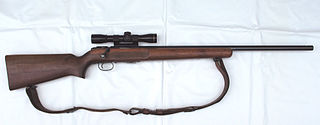| Remington-Keene | |
|---|---|
 Crow Dog with a Remington-Keene rifle, ca. 1898. | |
| Type | Rifle [1] |
| Place of origin | United States [1] |
| Service history | |
| Used by | United States Navy [1] |
| Production history | |
| Designer | John W. Keene [1] |
| Designed | 1878 [1] |
| Manufacturer | Remington Arms [1] |
| Unit cost | $17.50 [1] |
| No. built | 5,000 [1] |
| Variants | See text |
| Specifications | |
| Mass | 9 lb (4.1 kg) [1] |
| Length | 48 in (120 cm) [1] |
| Barrel length | 29.25 in (74.3 cm) [1] |
| Cartridge | .45-70 [1] |
| Action | Bolt action [1] |
| Feed system | 9-round tubular magazine [1] |
| Sights | folding leaf [1] |
The Remington-Keene is an early bolt-action rifle with a tube magazine.

A rifle is a portable, long-barrelled firearm designed for precision-oriented shooting, to be held with both hands and braced against the shoulder for stability during firing, and with a barrel that has a helical pattern of grooves ("rifling") cut into the bore wall. The term was originally rifled gun, with the word "rifle" referring to the machining process of creating groovings with cutting tools, and is now used for any long handheld device designed for well-aimed discharge activated by a trigger, such as the personnel halting and stimulation response rifle. Rifles are used extensively in warfare, law enforcement, hunting and shooting sports.
Remington manufactured prototypes of Keene's patents for consideration by the United States Army Ordnance Department Magazine Gun Board convened in 1878. Although the Army rejected the design in favor of the Winchester-Hotchkiss, Remington commenced production and offered the rifle to the United States Navy Bureau of Ordnance. The Navy purchased 250 rifles for comparison with their 2,500 Hotchkiss rifles and 300 M1885 Remington-Lee rifles. The Remington-Keene rifles were delivered in 1880 with US and an anchor stamped on the left side of the barrel and WWK and P (proof) stamped on the right side of the barrel by Lieutenant William W. Kimball. These rifles remained in service for less than a decade aboard USS Trenton (1876) and USS Michigan (1843). In July 1880 the United States Department of the Interior purchased 600 Frontier Model carbines with 24 in (61 cm) barrels to arm the Indian Police on a number of reservations in the western United States. Rifles were manufactured for civilian sales chambered for .45-70, .40-60 Winchester, and .43 Spanish. [1]

The United States Army (USA) is the land warfare service branch of the United States Armed Forces. It is one of the seven uniformed services of the United States, and is designated as the Army of the United States in the United States Constitution. As the oldest and most senior branch of the U.S. military in order of precedence, the modern U.S. Army has its roots in the Continental Army, which was formed to fight the American Revolutionary War (1775–1783)—before the United States of America was established as a country. After the Revolutionary War, the Congress of the Confederation created the United States Army on 3 June 1784 to replace the disbanded Continental Army. The United States Army considers itself descended from the Continental Army, and dates its institutional inception from the origin of that armed force in 1775.

The United States Navy (USN) is the naval warfare service branch of the United States Armed Forces and one of the seven uniformed services of the United States. It is the largest and most capable navy in the world and it has been estimated that in terms of tonnage of its active battle fleet alone, it is larger than the next 13 navies combined, which includes 11 U.S. allies or partner nations. With the highest combined battle fleet tonnage and the world's largest aircraft carrier fleet, with eleven in service, and two new carriers under construction. With 319,421 personnel on active duty and 99,616 in the Ready Reserve, the U.S. Navy is the third largest of the U.S. military service branches in terms of personnel. It has 282 deployable combat vessels and more than 3,700 operational aircraft as of March 2018, making it the third-largest air force in the world, after the United States Air Force and the United States Army.
The Bureau of Ordnance (BuOrd) was the U.S. Navy's organization responsible for the procurement, storage, and deployment of all naval weapons, between the years 1862 and 1959.









